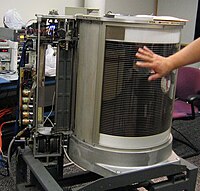
Photo from wikipedia
Abstract As a substitute for grinding, hard turning is becoming attractive in many manufacturing industries, although, it is interrupted by many problems like white layer and tensile residual stress which… Click to show full abstract
Abstract As a substitute for grinding, hard turning is becoming attractive in many manufacturing industries, although, it is interrupted by many problems like white layer and tensile residual stress which are generated during hard turning. Due to these reasons, many negative effects like residual stress, wear, and reduced fatigue life are found in the machined components. In the field of hard turning, the study on the white layer is the most interesting research subject among the scientific community. The white layer is one of the main reasons for cutting tool insert failure or excess insert wear. Also, the machined surface quality is affected due to the white layer. This work examines the development of the white layer in hard turning at different cutting speeds. All the experiments are executed on AISI 52100 grade steel (having hardness 55 HRC) with newly developed HSN2 coated carbide insert having a fresh edge for each experiment. Field emission scanning electron microscope, optical microscope and X-ray diffraction are used to analyze white layer at different cutting conditions as well as bulk material. In addition, the micro hardness of the machined surface is measured. Also, the workpiece surface and chip temperatures are studied. Based on analysis of white layers at different cutting speeds, it is observed that low cutting speed is more dominant during hard turning of AISI 52100 steel. The thickness of white layer reduces with increased cutting speed, and its maximum thickness (6.5 μm) is found at 100 m/min cutting speed, and their relationship is justified from analysis of X-ray diffraction peaks. Also, the weight percentage of retained austenite is calculated from XRD analysis and its value is 28.5% at a lower speed (100 m/min), and it reduces to 6.5% with higher cutting speed as compared to the base material.
Journal Title: Journal of Manufacturing Processes
Year Published: 2019
Link to full text (if available)
Share on Social Media: Sign Up to like & get
recommendations!